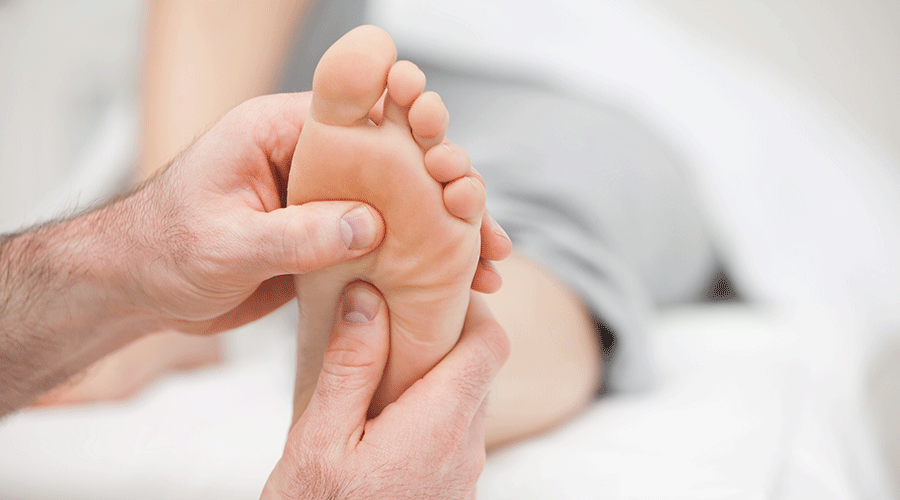
If you’re experiencing ongoing foot pain, minimally invasive (keyhole) surgery at Cleveland Clinic London can make a world of difference. This technique, which uses tiny incisions, enables many patients to bear weight without pain immediately after surgery.
Minimally Invasive Foot Surgery: Why Choose Cleveland Clinic London?
Mr David Redfern helped launch keyhole foot surgery in the U.K. and is a leading expert. He has developed and popularised several foot procedures and is co-creator of the MICA bunion surgery and big toe realignment. These methods help patients achieve results that are not possible with traditional open foot surgery.
Additional highlights of our care include:
- Life-changing procedure: The minimally invasive chevron and Akin (MICA) procedure can help eliminate nagging bunion pain for good. We perform a high volume of MICA procedures, enabling us to maintain exceptional outcomes. Mr Redfern trains foot surgeons from around the world on this technique, helping even more people get much-needed relief.
- Complex foot surgery: We use keyhole techniques to correct previous foot surgeries that were not successful. We carefully navigate scar tissue and existing surgical hardware to find and fix the source of the problem.
- Sports injury care: We excel in treating elite athletes, professional dancers and active people with recurring foot ligament injuries. Our offerings include ankle arthroscopy to assess bones and soft tissue inside the ankle joint. We also perform complex ligament reconstruction procedures that provide lasting joint stability.
- Appropriate therapies: Seeing a foot surgeon doesn’t always mean you’ll end up with surgery. We may recommend non-surgical treatments, such as special calf stretches to release tension and improve foot and ankle movement. If surgery is best, we provide all the necessary information so you can determine whether you wish to proceed.
- Convenience: We make it easier to fit foot procedures into your busy schedule. We typically see new patients within one week and perform surgery within two weeks. Patients often go home on the day of their procedure (day cases).
- Flexible payment options: Cleveland Clinic London accepts most major private medical insurance plans. Our team provides you with the information you need to get insurance approval.
Minimally Invasive Foot Procedures We Perform
Foot procedures using keyhole techniques include:
- Lesser toe surgery: These procedures correct deformities, such as hammertoes, claw toes and mallet toes, that do not involve the big toe.
- MICA bunion surgery: We remove the bunion, then realign your big toe bones and use screws to secure them in place.
- Cheilectomy for hallux rigidus (big toe arthritis): We remove bone spurs on the top of the big toe joint that are preventing natural movement. Read more about cheilectomy.
- Decompression osteotomy for hallux rigidus: This procedure is also known as minimally invasive hallux rigidus osteotomy (MIRO). We shorten the big toe bone by making tiny cuts in it, creating space that allows better joint movement.
- Calcaneal osteotomy: This procedure corrects ankle alignment in people with flat feet or unusually high arches. Your surgeon makes small cuts in your heel bone.
- Flatfoot surgery: We repair or replace damaged tendons and realign bones to restore your foot’s natural arch. This option can treat adult acquired flatfoot.
- Ankle ligament repair: We detach worn or damaged ligaments without interfering with surrounding anatomy by reattaching and tightening the ligament tissue. This restores joint stability and strength.
How keyhole foot surgery works
Your care journey starts with an in-person consultation. If you need diagnostic tests or scans, you can likely have them on the day of your visit. We explain your diagnosis and whether you are eligible for a keyhole procedure.
If minimally invasive foot surgery is right for you, here’s what to expect during the procedure:
- You receive medications (light sedation or general anaesthesia) that help you stay comfortable. We also deliver local anaesthetic. This combination provides excellent post-operative pain management.
- We make one or more small (a few millimetres) incisions to access the treatment area.
- Real-time imaging and tiny instruments enable us to carry out the procedure.
- After finishing the procedure, a few stitches are sometimes necessary. We use small dressings and a bandage to protect the surgical area.
After surgery:
- In most cases, it’s safe to bear full weight on your foot after the sedatives or anaesthesia wears off.
- You may need to wear a lightweight shoe or boot during the initial stages of recovery.
- For the best results, follow your post-surgery care instructions. These typically include taking it easy and elevating your foot for periods throughout the day.
Learn More About Minimally Invasive Foot Surgery
Contact us or call +44 20 3423 7500 for more information about minimally invasive foot surgery.
We make it easier to access expert care in the U.K. Read more about payment information, including options for self-pay and private medical insurance.
